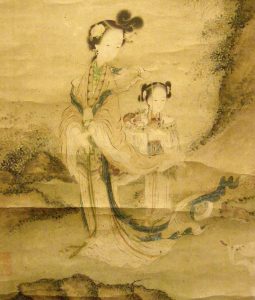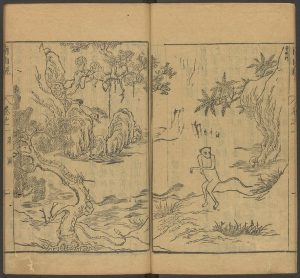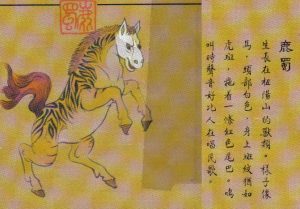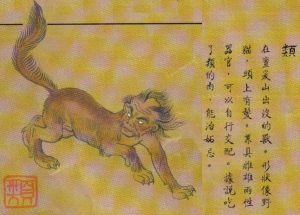25 Mount Kunlun, the Jade Mountain, and the Queen Mother of the West
Bianca Capozzi
Introduction
The mountains of China are saturated with many mystical and mysterious creatures. The legends that occupy China’s deep, deep history are profound and extensive. Beginning to try and unlock and discover the meaning behind mountains of China can be a tricky task. Yet when genuinely focusing on the meaning behind these mountains we realize that there’s a much more significant meaning than them just transpiring to be a mountain. Many of these mountains resembled heaven or divine like God’s. Especially since in China the spirits of the dead are extremely valued and feared as well by many, people believe that the souls of the deceased travel to these mountains as a haven. Each mountain holds specific fables and myths of the creatures that rest within them and what they represent.
Jade Mountain and Mount Kunlun: Background
Both of these mountains hold many tales and legends of what they represent as well as what lays inside them. For hundreds of years the people of China have looked to the mountains as a haven but as well as a place of the unknown. The queen mother of the West and the myths that go along with her, main focus here is the Jade Mountain which is where she is said to live. This relates to the jade worship, which played a significant role in ancient Chinese culture.[1] This was especially popular during the Shang and Zhou dynasties in terms of jade worship, this in turn lead to a national jade worship throughout China and a deep connection to the people of China and life and death.[2]Furthermore, mount Kunlun organically was predominantly named as a mythical mountain or a Taoist paradise. This first legend started with King Mu (976-922 BCE)
Kunlun is originally the name of a mythical mountain believed to be a Taoist paradise. The first to visit this paradise was, according to the legends, King Mu (976-922 BCE) Zhou Dynasty. According to the legend he discovered a Jade Palace of the Yellow Emperor who was said to be a mythical individual of Chinese culture. Furthemore he apparently the ‘Queen Mother of the West’, who was said to be a major part of ancient religious, especially during the Han Dynasty. She was said to reside in these mountains, and although she was feared she was also respected.

The Queen Mother of the West, who has various other local names, is a goddess who makes up a large part of Chinese culture throughout history. This mythology first appeared on oracle bone inscriptions of the fifteenth century BC (see also the chapter on Divination), except she was referred to as “Western Mother”.[3]
However, these inscriptions indicated she was mostly related to Taoism. Her name is exactly that, the Queen Mother of the west, she is in fact a queen and associated with the west. She is most associated with prosperity or a heavenly like place. The Queen mother the west was first mentioned in oracle bone inscriptions during the Shang dynasty. One inscription reads: “Crack-making on day IX (9th day), we divined. If we make offering to the eastern mother and the western mother, there will be approval.” This in turn means that if you are to go west to the Queen Mother you can find divinity. However, the exact nature of the Queen Mother’s divinities in the Shang dynasty is unknown but she was seen as a powerful force.[4] In the Classic of Mountains and Seas during the Zhou dynasty she was seen as a ferocious goddess with the teeth of a tiger and people feared her but during the Taoist time she was seen as a goddess or immortality and life.
Creatures that lay within the mountains
According to Chines folklore the mountains aren’t just a place or prosperity but also a place that strange creatures are said to reside. These creature in most cases are not only odd or scary looking but many possesed powers that rained fear down on the people of China. The Classic of Mountains and Seas depicts these creatures and describes each one in great detail. Since it would be nearly impossible to describe each creature in detail, I will give you a few examples of exactly what I am talking about, today we have the opportunity to now have access to more then 350 gods, hero, and demons and over 550 book records, however the Guideways were edited by Emperor Ming of the Han dynasty and it was regarded as a loss of knowledge. However today these strange creatures aren’t well known in China and don’t play a role in how people go about their daily lives. It is interesting though how unlike other European cultures these creatures were looked at as entities that could be found in the mountains. This in turn shows how the Chinese dwelled on the idea of the heaven and earth concept and everything/everyone that was associated with it. For those of you who don’t know what a Guideway is a place or a thing that falls into the following three categories, “those that convey fairly comprehensible meanings that can often be related to the accompanying descriptions; those that register an ambiguous meaning or multiple meanings that may or may not be related to the descriptions; and those that cannot be understood with any certainty even if the graphs may function semantically in other contexts.” Furthermore, as future reference here are the measures that appear in the Guideways, however there was some local variation throughout China and different orical standards.[5]
Those listed below are approximate equivalences based on data from the seventeenth through the nineteenth century.
- 1 bu = 5 Chinese feet ( chi ÿ ) or 60.5 inches
- 1 chi = a Chinese foot or 14.1 inches (linear), 12.1 inches (itinerary)
- 1 li = 1/3 of a mile or 1821.15 feet
- 1 ren = 7 Chinese feet or 98.7 inches
- 1 xun = 8 Chinese feet or 112.8 inches
- 1 zhang = 10 Chinese feet or 141 inches
- 1 jin = 1.33 lbs.
- 1 shi = 160 lbs. (weight), 23.4 gallons (volume)
During this time in ancient China these strange creatures were abundant across the landscape it was nearly impossible to know all of them and their names or appearances. There are many early texts of visitors that came to China to find scholars, orcial scribe-astrologers, diviners, and shamans, among others, to discover which god is caused a disturbance and why. After all who wouldn’t be curious about a new and vastly different culture. The Guideways fulfill the need for a reference of where all these entities, people, and places could be found. It records more than 500 creatures, 550 mountains, 300 rivers, 95 foreign lands and tribes, 130 kinds of pharmaceuticals (to prevent some 70 illnesses), 435 plants, 90 metals and minerals, and lastly specific forms of ritual sacrifice to various mountain gods. When zeroing in on the creatures of these places in the mountains it is important to keep in mind some of these places exists and other were just simply said to exist.[6]
Now we will take a look at some of the creatures that were said to reside in these mysterious mountains, as I stated earlier there are so many different creatures, so I can’t go through each and every one, but I can provide some background to a few interesting ones.
Xingxing: Can be found throughout the Southern Mountains, it walks crouched over but runs like a man. It is said that eating it enhances one’s ability to run. The Xingxing is also talked about “in chapter 10 [no. 263 in Strassberg’s book] as resembling a pig with a human face as well as in chapter 18, where it is said to be capable of identifying people by name.”[7]

Lushu: In the southern mountains “there is a beast whose body resembles a horse with a white head, stripes like a tiger, and a red tail. It makes a sound like a man singing…Guo Pu in his Encomiums to the Guideways through Mountains and Seas (Shanhaijing tuzan, c. 320) specified that one should use its skin and hair for a talisman.” [8]

Lei: “Four hundred li farther east is Mount Chanyuan” where the Lei can be found, the Lei “is both male and female”, “whose form resembles a wildcat with a mane”. It was said to be able to cure jealousy, and in later records was said to help with fertilization.[9]

As you can see the list can go on and on, some of these creatures were feared while other were sought out for their great powers. Either way the people of Ancient China greatly respected these creatures and without the guide ways there would be no true form of direction or sense of where things are located without them.
Bibliography
A Chinese Bestiary: Strange Creatures from the Guideways through Mountains and Seas = 山海經.
Edited and Translated with Commentary by Richard E. Strassberg. Berkeley: University of California Press, 2002.
The Columbia Anthology of Traditional Chinese Literature. Edited by Victor H. Mair. New York: Columbia University Press, 1994.
“Jade Mountain, a Mythology Fiction.” FictionPress. https://www.fictionpress.com/s/1360612/1/Jade-Mountain.
Lullo, Sheri A. “Female Divinities in Han Dynasty Representation”. In Gender and Chinese Archaeology, edited by Katheryn M. Linduff and Yan Sun, 259-287. Walnut Creek, CA: AltaMira Press, 2004.
Wu, Juan. “Mythical Image of “Queen Mother of the West” and Metaphysical Concept of Chinese Jade Worship in Classic of Mountains and Seas.” IOSR Journal Of Humanities And Social Science. https://pdfs.semanticscholar.org/151f/eaa103ba29aeca70a67b5f15fcf3e95ba7b3.pdf.
- The Columbia Anthology of Traditional Chinese Literature, edited by Victor H. Mair (New York: Columbia University Press, 1994), xx. ↵
- "Jade Mountain, a Mythology Fiction." FictionPress. Accessed May 05, 2019. https://www.fictionpress.com/s/1360612/1/Jade-Mountain. ↵
- Sheri A. Lullo, “Female Divinities in Han Dynasty Representation”, in Gender and Chinese Archaeology, edited by Katheryn M. Linduff and Yan Sun (Walnut Creek, CA: AltaMira Press, 2004), 259-287; Juan Wu, "Mythical Image of 'Queen Mother of the West' and Metaphysical Concept of Chinese Jade Worship in Classic of Mountains and Seas," in IOSR Journal Of Humanities And Social Science 21: 11 (2016), 39-46. https://pdfs.semanticscholar.org/151f/eaa103ba29aeca70a67b5f15fcf3e95ba7b3.pdf. ↵
- Juan Wu, "Mythical Image of 'Queen Mother of the West'". ↵
- A Chinese Bestiary: Strange Creatures from the Guideways through Mountains and Seas = 山海經, edited and translated with commentary by Richard E. Strassberg (Berkeley: University of California Press, 2002). Accessed April 29, 2019. ProQuest Ebook Central. ↵
- Ibid. ↵
- Ibid., p. 84. ↵
- Ibid., p. 86. ↵
- Strassberg, p. 86 ↵
